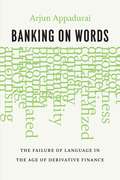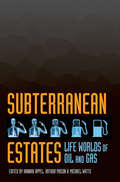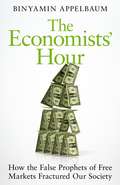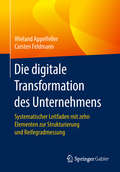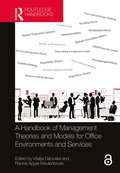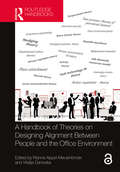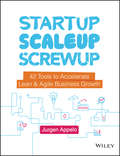- Table View
- List View
Banking on Words: The Failure of Language in the Age of Derivative Finance
by Arjun AppaduraiIn this provocative look at one of the most important events of our time, renowned scholar Arjun Appadurai argues that the economic collapse of 2008—while indeed spurred on by greed, ignorance, weak regulation, and irresponsible risk-taking—was, ultimately, a failure of language. To prove this sophisticated point, he takes us into the world of derivative finance, which has become the core of contemporary trading and the primary target of blame for the collapse and all our subsequent woes. With incisive argumentation, he analyzes this challengingly technical world, drawing on thinkers such as J. L. Austin, Marcel Mauss, and Max Weber as theoretical guides to showcase the ways language—and particular failures in it—paved the way for ruin. Appadurai moves in four steps through his analysis. In the first, he highlights the importance of derivatives in contemporary finance, isolating them as the core technical innovation that markets have produced. In the second, he shows that derivatives are essentially written contracts about the future prices of assets—they are, crucially, a promise. Drawing on Mauss’s The Gift and Austin’s theories on linguistic performatives, Appadurai, in his third step, shows how the derivative exploits the linguistic power of the promise through the special form that money takes in finance as the most abstract form of commodity value. Finally, he pinpoints one crucial feature of derivatives (as seen in the housing market especially): that they can make promises that other promises will be broken. He then details how this feature spread contagiously through the market, snowballing into the systemic liquidity crisis that we are all too familiar with now. With his characteristic clarity, Appadurai explains one of the most complicated—and yet absolutely central—aspects of our modern economy. He makes the critical link we have long needed to make: between the numerical force of money and the linguistic force of what we say we will do with it.
Banking on Words: The Failure of Language in the Age of Derivative Finance
by Arjun AppaduraiIn this provocative look at one of the most important events of our time, renowned scholar Arjun Appadurai argues that the economic collapse of 2008—while indeed spurred on by greed, ignorance, weak regulation, and irresponsible risk-taking—was, ultimately, a failure of language. To prove this sophisticated point, he takes us into the world of derivative finance, which has become the core of contemporary trading and the primary target of blame for the collapse and all our subsequent woes. With incisive argumentation, he analyzes this challengingly technical world, drawing on thinkers such as J. L. Austin, Marcel Mauss, and Max Weber as theoretical guides to showcase the ways language—and particular failures in it—paved the way for ruin. Appadurai moves in four steps through his analysis. In the first, he highlights the importance of derivatives in contemporary finance, isolating them as the core technical innovation that markets have produced. In the second, he shows that derivatives are essentially written contracts about the future prices of assets—they are, crucially, a promise. Drawing on Mauss’s The Gift and Austin’s theories on linguistic performatives, Appadurai, in his third step, shows how the derivative exploits the linguistic power of the promise through the special form that money takes in finance as the most abstract form of commodity value. Finally, he pinpoints one crucial feature of derivatives (as seen in the housing market especially): that they can make promises that other promises will be broken. He then details how this feature spread contagiously through the market, snowballing into the systemic liquidity crisis that we are all too familiar with now. With his characteristic clarity, Appadurai explains one of the most complicated—and yet absolutely central—aspects of our modern economy. He makes the critical link we have long needed to make: between the numerical force of money and the linguistic force of what we say we will do with it.
Marketing Brands in Africa: Perspectives on the Evolution of Branding in an Emerging Market (Palgrave Studies of Marketing in Emerging Economies)
by Samuelson AppauThis contributed volume serves as an authoritative reference and guide for anyone looking to study or build a brand in Africa. Despite being touted as the ‘last frontier’ of global brands, very little research exists that examines brands and branding in this emerging market. Authors cover crucial topics such as the history of branding in Africa, branding approaches used by start-ups, religious organizations, political parties, and businesses in the informal economies of Africa, as well as marketing Africa as a brand using practical cases, empirical and critical approaches.With the world’s youngest population and the second-fastest growing economies, Africa has quickly become a hotbed for marketing and consumption of local and global brands. While past research has mostly focused on examining the brand image of Africa and African countries, or on branding Africa as a place for tourist consumption, what is missing is a comprehensive guide that discusses the theory and practice of branding and brands in and from Africa. Through theoretical and practical contributions, the authors of this book seek to fill the knowledge gap about branding in and from Africa.
Strategische Potentiale der Technologieentwicklung: Implikationen für Software-Entscheidungen
by Dietmar H. AppelDie Grenzen der Entwicklungsfähigkeit herkömmlicher Informationstechnologien scheinen bereits erreicht zu sein. Der Autor legt die Entscheidungsvorbereitung für einen softwaretechnologischen Umstieg am Beispiel des Übergangs zum Paradigma der Objektorientierung dar.
Cybervetting: Internet Searches for Vetting, Investigations, and Open-Source Intelligence, Second Edition
by Edward J. AppelResearching an individual‘s, firm‘s or brands online presence has become standard practice for many employers, investigators, and intelligence officers, including law enforcement. Countless companies and organizations are implementing their own policies, procedures, and practices for Internet investigations, cybervetting, and intelligence.
Quick Guide Crypto Assets: How they Classify within the Framework of Financial Market Law
by Hannah AppelIn this book, the complex topic of crypto securities is presented in a compact, understandable and practical manner. In addition to conveying the fundamentals and technical background of the crypto market, a classification in the various areas of supervisory law is made. The focus is on German law, although reference is also made to the European equivalence standards. In order to succeed in a correct classification into European financial market law, both the Liechtenstein law on tokens and VT service providers and the European proposal for a regulation on markets for crypto assets are discussed in detail and compared with the German supervisory regulations on crypto assets. The aim, in addition to creating a basic understanding of how crypto assets work, is to construct a comprehensive overall picture of their regulatory treatment in Germany and to include possible implications of a European push. The work thus provides guidance to individuals who, for example, wish to invest in cryptocurrencies or start a business related to cryptocurrencies.
Quick Guide Kryptowerte: Wie eine Einordnung in das Finanzmarktrecht gelingt (Quick Guide)
by Hannah AppelIn diesem Buch wird das komplexe Thema der Kryptowerte kompakt, verständlich und praxisnah dargelegt. Neben der Vermittlung der Grundlagen und technischen Hintergründe des Kryptomarktes, wird eine Einordnung in die verschiedenen Bereiche des Aufsichtsrechts vorgenommen. Der Schwerpunkt liegt dabei auf dem deutschen Recht, wenngleich auch auf die europäischen Äquivalenznormen verwiesen wird. Damit eine korrekte Einordnung in das europäische Finanzmarktrecht gelingt, werden sowohl das liechtensteinische Gesetz über Token und VT-Dienstleister als auch der europäische Vorschlag für eine Verordnung über Märkte für Kryptowerte ausführlich besprochen und mit den deutschen aufsichtsrechtlichen Regelungen zu Kryptowerten verglichen. Ziel ist es, neben der Schaffung eines grundlegenden Verständnisses der Funktionsweise von Kryptowerten, ein umfassendes Gesamtbild ihrer regulatorischen Behandlung in Deutschland zu konstruieren und mögliche Auswirkungen eines europäischen Vorstoßes einzubeziehen.Das Werk bietet damit eine Orientierungshilfe für Personen, die z. B. in Kryptowerte investieren oder ein Unternehmen im Zusammenhang mit Kryptowerten gründen möchten.
Subterranean Estates: Life Worlds of Oil and Gas
by Hannah Appel Arthur Mason Michael Watts"Oil is a fairy tale, and, like every fairy tale, is a bit of a lie."—Ryzard Kapuscinski, Shah of ShahsThe scale and reach of the global oil and gas industry, valued at several trillions of dollars, is almost impossible to grasp. Despite its vast technical expertise and scientific sophistication, the industry betrays a startling degree of inexactitude and empirical disagreement about foundational questions of quantity, output, and price. As an industry typified by concentrated economic and political power, its operations are obscured by secrecy and security. Perhaps it is not surprising, then, that the social sciences typically approach oil as a metonym—of modernity, money, geopolitics, violence, corruption, curse, ur-commodity—rather than considering the daily life of the industry itself and of the hydrocarbons around which it is built.Subterranean Estates gathers an interdisciplinary group of scholars and experts to instead provide a critical topography of the hydrocarbon industry, understood not solely as an assemblage of corporate forms but rather as an expansive and porous network of laborers and technologies, representation and expertise, and the ways of life oil and gas produce at points of extraction, production, marketing, consumption, and combustion. By accounting for oil as empirical and experiential, the contributors begin to demystify a commodity too often given almost demiurgic power. Subterranean Estates shifts critical attention away from an exclusive focus on global oil firms toward often overlooked aspects of the industry, including insurance, finance, law, and the role of consultants and community organizations. Based on ethnographic research from around the world (Equatorial Guinea, Nigeria, Oman, the United States, Ecuador, Chad, the United Kingdom, Kazakhstan, Canada, Iran, and Russia), and featuring a photoessay on the lived experiences of those who inhabit a universe populated by oil rigs, pipelines, and gas flares, this innovative volume provides a new perspective on the material, symbolic, cultural, and social meanings of this multidimensional world.
Tax Politics in Eastern Europe: Globalization, Regional Integration, and the Democratic Compromise
by Hilary Appel“This is the first book to systematically examine the variation in policies of Eastern European countries. There is a theoretical contribution to understandings of variation in tax policies, but just as impressive is the in-depth empirical analysis and in particular the data from interviews with key players in the process.” —Yoshiko Herrera, University of Wisconsin-Madison Post-Communist tax reform, like institutional reform in other areas of the post-Communist transition, holds tremendous material consequences for different groups in society. Consequently, one would expect the allocation of resources and the distribution of the financial burden of that allocation to be highly sensitive to domestic politics. Indeed the political stakes should be especially high since post-Communist tax reform requires not merely a simple adjustment at the margin, but the fundamental reallocation of the responsibility for government revenue. In Eastern Europe, however, important areas of tax policy do not reflect traditional domestic variables (e.g., interest groups and partisanship) so much as the international imperatives associated with regional and global economic integration. In Tax Politics in Eastern Europe, Hilary Appel analyzes the domestic and international factors that drive tax policy. She begins with a review of the greatest challenges in the initial creation of the capitalist tax systems in former Communist states and then turns to the evolution of specific forms of taxation in order to gauge the relative impact of domestic politics on tax policy. Appel concludes that, although some tax areas, such as personal income taxes, remain politicized, most other taxes, such as corporate income taxes and all forms of consumption taxes, have been less subject to domestic political pressures because of powerful constraints resulting from regional and global economic integration.
Bürowirtschaft: Ein Lehr- und Arbeitsbuch mit praktischen Fällen für die Ausbildung in Büroberufen
by Jo AppelGabler Büro Lexikon
by Jo Appel Manfred Leubner Wolfgang Manekeller Ute Mielow Helga Rühling Annelore Schliz Annemarie WeighardtDas wirtschaftliche Krankenhauslaboratorium: Leistung und Kosten (INSTAND-Schriftenreihe #9)
by S. Appel S. L. Braun J. Dessauer W. Ehret H. J. Gibitz O. Henker W. Hinsch N. Petersen W. Stein G. Weidemann M. Rk ZluhanDie Veränderungen bei den Krankenhauspflegesätzen ziehen weite Kreise bei den Kosten für Labormanagement und Kostenermittlung des dazugehörigen Personals. In diesem Buch hat ein Autorenkollektiv Standards entwickelt, die für Betriebs- und Volkswirte im Management eines Krankenhauses eine entscheidende Hilfe sind.
The Economists' Hour: How the False Prophets of Free Markets Fractured Our Society
by Binyamin AppelbaumThe story of the economists who championed the rise of free markets and fundamentally reshaped the modern world.As the post-World War II economic boom began to falter in the late 1960s, a new breed of economists gained in influence and power. Over time, their ideas curbed governments, unleashed corporations and hastened globalization.Their fundamental belief? That governments should stop trying to manage the economy.Their guiding principle? That markets would deliver steady growth and broad prosperity.But the economists’ hour failed to deliver on its premise. The single-minded embrace of markets has come at the expense of economic equality, of the health of liberal democracy, and of future generations. Across the world, from both right and left, the assumptions of the once-dominant school of free-market economic thought are being challenged, as we count the costs as well as the gains of its influence.Both accessible and authoritative, exploring the impact of both ideas and individuals, Binyamin Appelbaum’s The Economists’ Hour provides both a reckoning with the past and a call fora different future.
Supplier Relationship Management: Strategie, Organisation und IT des modernen Beschaffungsmanagements
by Wieland Appelfeller Wolfgang BuchholzWieland Appelfeller und Wolfgang Buchholz verstehen Supplier Relationship Management als die von einer Beschaffungsgesamtstrategie ausgehende Gestaltung der strategischen und operativen Beschaffungsprozesse unter Nutzung konventioneller und internetgestützter IT. Auf Basis des 3-Ebenen-Modell wird beschrieben, wie die Beschaffung insbesondere unter Nutzung moderner IT systematisch optimiert werden kann. Für die 2. Auflage wurden das Instrumentarium für die strategische Analyse, die Strategieformulierung und die Strategieimplementierung ergänzt, Weiterentwicklungen bei den IT-Systemen dargestellt, die beschriebenen Modelle und Methoden an aktuelle Entwicklungen angepasst und neue Praxisbeispiele aufgenommen.
Die digitale Transformation des Unternehmens: Systematischer Leitfaden mit zehn Elementen zur Strukturierung und Reifegradmessung
by Wieland Appelfeller Carsten FeldmannDie digitale Transformation von Unternehmen ist aktuell eine zentrale Herausforderung im betriebswirtschaftlichen Kontext. Einen Handlungsrahmen, der das vielschichtige Thema strukturiert, einfach erklärt und eine systematische Anleitung zur Digitalisierung bietet, gibt es bisher nicht. Diese Lücke schließt das Buch, das sich gleichermaßen an Praktiker und Studierende wendet.Das digitale Unternehmen wird über zehn Elemente, z. B. Prozesse, Produkte, Geschäftsmodell und Daten, praxisorientiert dargestellt. Für jedes Element wird anschaulich erläutert, was dessen digitale Transformation konkret bedeutet und in welchen Stufen diese umsetzbar ist. Handlungsempfehlungen und zahlreiche Beispiele zeigen, wie eine schrittweise Digitalisierung des Unternehmens erfolgen kann. Dabei wird auch hinterfragt, wie weit eine Digitalisierung tatsächlich sinnvoll ist. Traditionelle Ansätze der digitalen Transformation wie die Prozess-Digitalisierung werden ebenso beschrieben wie neuere Ansätze, beispielsweise die Digitalisierung von Produkten oder das Internet of Things. Der Leitfaden lässt sich auf einzelne Branchen und Unternehmen anpassen, um die Anwendbarkeit in der Praxis zu vereinfachen.
Die digitale Transformation des Unternehmens: Systematischer Leitfaden mit zehn Elementen zur Strukturierung und Reifegradmessung
by Wieland Appelfeller Carsten FeldmannDie digitale Transformation ist eine zentrale Herausforderung für Unternehmen. Dieses Buch bietet einen Handlungsrahmen, der das vielschichtige Thema strukturiert, aus einer vorwiegend betriebswirtschaftlichen Sicht einfach erklärt und eine systematische Anleitung zur Digitalisierung bietet. Es richtet sich gleichermaßen an Praktiker und Studierende.Das digitale Unternehmen wird über zehn Elemente, z. B. Prozesse, Produkte, Geschäftsmodell und Daten, praxisorientiert dargestellt. Für jedes Element wird anschaulich erläutert, was dessen digitale Transformation konkret bedeutet und in welchen Stufen diese umsetzbar ist. Handlungsempfehlungen und zahlreiche Beispiele zeigen, wie eine schrittweise Digitalisierung des Unternehmens erfolgen kann. Dabei wird auch hinterfragt, wie weit eine Digitalisierung tatsächlich sinnvoll ist. Traditionelle Ansätze der digitalen Transformation wie die Prozess-Digitalisierung werden ebenso beschrieben wie neuere Ansätze, beispielsweise die Digitalisierung von Produkten oder das Internet of Things. Zusätzlich zu den zehn Elementen werden digitale Technologien wie Robotic Process Automation (RPA), Process Mining, Blockchain oder 3D-Druck beschrieben, die als Enabler der digitalen Transformation interpretiert werden. Nutzenbewertungen von Investitionen sowie das begleitende Change Management und eine umfassende Fallstudie, die die komplette Transformation eines Unternehmens darstellt, runden das Buch ab.
A Handbook of Management Theories and Models for Office Environments and Services
by Rianne Appel-Meulenbroek Vitalija DanivskaAlthough workplace design and management are gaining more and more attention from modern organizations, workplace research is still very fragmented and spread across multiple disciplines in academia. There are several books on the market related to workplaces, facility management (FM), and corporate real estate management (CREM) disciplines, but few open up a theoretical and practical discussion across multiple theories from different disciplines. Therefore, workplace researchers are not aware of all the angles from which workplace management and effects of workplace design on employees has been or could be studied. A lot of knowledge is lost between disciplines, and sadly, many insights do not reach workplace managers in practice. Therefore, this new book series is started by associate professor Rianne Appel-Meulenbroek (Eindhoven University of Technology, the Netherlands) and postdoc researcher Vitalija Danivska (Aalto University, Finland) as editors, published by Routledge. It is titled ‘Transdisciplinary Workplace Research and Management’ because it bundles important research insights from different disciplinary fields and shows its relevance for both academic workplace research and workplace management in practice. The books will address the complexity of the transdisciplinary angle necessary to solve ongoing workplace-related issues in practice, such as knowledge worker productivity, office use, and more strategic management. In addition, the editors work towards further collaboration and integration of the necessary disciplines for further development of the workplace field in research and in practice. This book series is relevant for workplace experts both in academia and industry. This second book in the series focuses on the role of workplace management in the organization and the tasks that workplace management needs to consider. The 18 theories that are presented in this book and applied to workplace research discuss management aspects from the organization’s perspective or dive deeper into issues related to people and/or building management. They all emphasize that workplace management is a complex matter that requires more strategic attention in order to add value for various stakeholders. The final chapter of the book describes a first step towards integrating the presented theories into an interdisciplinary framework for developing a grand workplace management theory.
A Handbook of Management Theories and Models for Office Environments and Services
by Rianne Appel-Meulenbroek Vitalija DanivskaAlthough workplace design and management are gaining more and more attention from modern organizations, workplace research is still very fragmented and spread across multiple disciplines in academia. There are several books on the market related to workplaces, facility management (FM), and corporate real estate management (CREM) disciplines, but few open up a theoretical and practical discussion across multiple theories from different disciplines. Therefore, workplace researchers are not aware of all the angles from which workplace management and effects of workplace design on employees has been or could be studied. A lot of knowledge is lost between disciplines, and sadly, many insights do not reach workplace managers in practice. Therefore, this new book series is started by associate professor Rianne Appel-Meulenbroek (Eindhoven University of Technology, the Netherlands) and postdoc researcher Vitalija Danivska (Aalto University, Finland) as editors, published by Routledge. It is titled ‘Transdisciplinary Workplace Research and Management’ because it bundles important research insights from different disciplinary fields and shows its relevance for both academic workplace research and workplace management in practice. The books will address the complexity of the transdisciplinary angle necessary to solve ongoing workplace-related issues in practice, such as knowledge worker productivity, office use, and more strategic management. In addition, the editors work towards further collaboration and integration of the necessary disciplines for further development of the workplace field in research and in practice. This book series is relevant for workplace experts both in academia and industry. This second book in the series focuses on the role of workplace management in the organization and the tasks that workplace management needs to consider. The 18 theories that are presented in this book and applied to workplace research discuss management aspects from the organization’s perspective or dive deeper into issues related to people and/or building management. They all emphasize that workplace management is a complex matter that requires more strategic attention in order to add value for various stakeholders. The final chapter of the book describes a first step towards integrating the presented theories into an interdisciplinary framework for developing a grand workplace management theory.
A Handbook of Theories on Designing Alignment Between People and the Office Environment
by Rianne Appel-Meulenbroek Vitalija DanivskaAlthough workplace design and management are gaining more and more attention from modern organizations, workplace research is still very fragmented and spread across multiple disciplines in academia. There are several books on the market related to workplaces, facility management (FM), and corporate real estate management (CREM) disciplines, but few open up a theoretical and practical discussion across multiple theories from different fields of studies. Therefore, workplace researchers are not aware of all the angles from which workplace management and effects of workplace design on employees has been or could be studied. A lot of knowledge is lost between disciplines, and sadly, many insights do not reach workplace managers in practice. Therefore, this new book series is started by associate professor Rianne Appel-Meulenbroek (Eindhoven University of Technology, the Netherlands) and postdoc researcher Vitalija Danivska (Aalto University, Finland) as editors, published by Routledge. It is titled ‘Transdisciplinary Workplace Research and Management’ because it bundles important research insights from different disciplinary fields and shows its relevance for both academic workplace research and workplace management in practice. The books will address the complexity of the transdisciplinary angle necessary to solve ongoing workplace-related issues in practice, such as knowledge worker productivity, office use, and more strategic workplace management. In addition, the editors work towards further collaboration and integration of the necessary disciplines for further development of the workplace field in research and in practice. This book series is relevant for workplace experts both in academia and industry. This first book in the series focuses on the employee as a user of the work environment. The 21 theories discussed and applied to workplace design in this book address people’s ability to do their job and thrive in relation to the office workplace. Some focus more on explaining why people behave the way they do (the psychosocial environment), while others take the physical and/or digital workplace quality as a starting point to explain employee outcomes such as health, satisfaction, and performance. They all explain different aspects for achieving employee-workplace alignment (EWA) and thereby ensuring employee thriving. The final chapter describes a first step towards integrating these theories into an overall interdisciplinary framework for eventually developing a grand EWA theory. The Open Access version of this book, available at http://www.taylorfrancis.com/books/e/9781003128830, has been made available under a Creative Commons Attribution-Non Commercial-No Derivatives 4.0 license.
Managing for Happiness: Games, Tools, and Practices to Motivate Any Team
by Jurgen AppeloA practical handbook for making management great again Managing for Happiness offers a complete set of practices for more effective management that makes work fun. Work and fun are not polar opposites; they're two sides of the same coin, and making the workplace a pleasant place to be keeps employees motivated and keeps customers coming back for more. It's not about gimmicks or 'perks' that disrupt productivity; it's about finding the passion that drives your business, and making it contagious. This book provides tools, games, and practices that put joy into work, with practical, real-world guidance for empowering workers and delighting customers. These aren't break time exploits or downtime amusements—they're real solutions for common management problems. Define roles and responsibilities, create meaningful team metrics, and replace performance appraisals with something more useful. An organization's culture rests on the back of management, and this book shows you how to create change for the better. Somewhere along the line, people collectively started thinking that work is work and fun is something you do on the weekends. This book shows you how to transform your organization into a place with enthusiastic Monday mornings. Redefine job titles and career paths Motivate workers and measure team performance Change your organization's culture Make management—and work—fun again Modern organizations expect everyone to be servant leaders and systems thinkers, but nobody explains how. To survive in the 21st century, companies need to dig past the obvious and find what works. What keeps top talent? What inspires customer loyalty? The answer is great management, which inspires great employees, who then provide a great customer experience. Managing for Happiness is a practical handbook for achieving organizational greatness.
Managing for Happiness: Games, Tools, and Practices to Motivate Any Team
by Jurgen AppeloA practical handbook for making management great again Managing for Happiness offers a complete set of practices for more effective management that makes work fun. Work and fun are not polar opposites; they're two sides of the same coin, and making the workplace a pleasant place to be keeps employees motivated and keeps customers coming back for more. It's not about gimmicks or 'perks' that disrupt productivity; it's about finding the passion that drives your business, and making it contagious. This book provides tools, games, and practices that put joy into work, with practical, real-world guidance for empowering workers and delighting customers. These aren't break time exploits or downtime amusements—they're real solutions for common management problems. Define roles and responsibilities, create meaningful team metrics, and replace performance appraisals with something more useful. An organization's culture rests on the back of management, and this book shows you how to create change for the better. Somewhere along the line, people collectively started thinking that work is work and fun is something you do on the weekends. This book shows you how to transform your organization into a place with enthusiastic Monday mornings. Redefine job titles and career paths Motivate workers and measure team performance Change your organization's culture Make management—and work—fun again Modern organizations expect everyone to be servant leaders and systems thinkers, but nobody explains how. To survive in the 21st century, companies need to dig past the obvious and find what works. What keeps top talent? What inspires customer loyalty? The answer is great management, which inspires great employees, who then provide a great customer experience. Managing for Happiness is a practical handbook for achieving organizational greatness.
Startup, Scaleup, Screwup: 42 Tools to Accelerate Lean and Agile Business Growth
by Jurgen AppeloReal-world tools to build your venture, grow your business, and avoid mistakes Startup, Scaleup, Screwup is an expert guide for emerging and established businesses to accelerate growth, facilitate scalability, and keep pace with the rapidly changing economic landscape. The contemporary marketplace is more dynamic than ever before—increased global competition, the impact of digital transformation, and disruptive innovation factors require businesses to implement agile management and business strategies to compete and thrive. This indispensable book provides business leaders and entrepreneurs the tools and guidance to meet growth and scalability challenges head on. Equal parts motivation and practical application, this book answers the questions every business leader asks from the startup ventures to established companies. Covering topics including funding options, employee hiring, product-market validation, remote team management, agile scaling, and the business lifecycle, this essential resource provides a solid approach to grow at the right pace and stay lean. This book will enable you to: Apply 42 effective tools to sustain and accelerate your business growth Avoid the mistakes and pitfalls associated with rapid business growth or organizational change Develop a clear growth plan to integrate into your overall business model Structure your business for rapid scaling and efficient management Startup, Scaleup, Screwup: 42 Tools to Accelerate Lean & Agile Business Growth is a must-read for entrepreneurs, founders, managers, and senior executives. Author Jurgen Appelo shares his wisdom on the creative economy, agile management, innovation marketing, and organizational change to provide a comprehensive guide to business growth. Practical methods and expert advice make this book an essential addition to any business professional’s library.
Startup, Scaleup, Screwup: 42 Tools to Accelerate Lean and Agile Business Growth
by Jurgen AppeloReal-world tools to build your venture, grow your business, and avoid mistakes Startup, Scaleup, Screwup is an expert guide for emerging and established businesses to accelerate growth, facilitate scalability, and keep pace with the rapidly changing economic landscape. The contemporary marketplace is more dynamic than ever before—increased global competition, the impact of digital transformation, and disruptive innovation factors require businesses to implement agile management and business strategies to compete and thrive. This indispensable book provides business leaders and entrepreneurs the tools and guidance to meet growth and scalability challenges head on. Equal parts motivation and practical application, this book answers the questions every business leader asks from the startup ventures to established companies. Covering topics including funding options, employee hiring, product-market validation, remote team management, agile scaling, and the business lifecycle, this essential resource provides a solid approach to grow at the right pace and stay lean. This book will enable you to: Apply 42 effective tools to sustain and accelerate your business growth Avoid the mistakes and pitfalls associated with rapid business growth or organizational change Develop a clear growth plan to integrate into your overall business model Structure your business for rapid scaling and efficient management Startup, Scaleup, Screwup: 42 Tools to Accelerate Lean & Agile Business Growth is a must-read for entrepreneurs, founders, managers, and senior executives. Author Jurgen Appelo shares his wisdom on the creative economy, agile management, innovation marketing, and organizational change to provide a comprehensive guide to business growth. Practical methods and expert advice make this book an essential addition to any business professional’s library.
Datenbanksysteme in Büro, Technik und Wissenschaft: GI-Fachtagung, Kaiserslautern, 6.–8.März, 1991 Proceedings (Informatik-Fachberichte #270)
by Hans-Jürgen AppelrathIn den letzten Jahren haben im Bereich der Datenbankverwaltung neue Anwendungen und Einsatzgebiete zahlreiche neuartige Forschungsprobleme und Entwicklungsaufgaben hervorgebracht. Dabei handelt es sich vorwiegend um Anwendungen aus den Gebieten CAD/CAM, VLSI-Entwurf, Software-Entwicklung, geographische Informationssysteme, Büroautomatisierung, Expertensysteme usw., die oft als Non-Standard-Anwendungen zusammengefaßt werden. In vielen Forschungsprojekten werden bereits aussichtsreiche Lösungsvorschläge für solche Aufgabenstellungen untersucht und durch Prototypimplementierungen getestet. Dadurch lassen sich Leistungsverhalten und andere Systemeigenschaften künftiger Datenhaltungssysteme schon relativ genau charakterisieren. Ziel dieses Informatik-Fachberichtes ist es, eine aktuelle Darstellung und Diskussion der Probleme und Anforderungen sowie der neuen Forschungs- und Entwicklungsergebnisse im Bereich der Datenbankverwaltung für Non-Standard-Anwendungen zu bieten.
IT-Architekturentwicklung im Smart Grid: Perspektiven für eine sichere markt- und standardbasierte Integration erneuerbarer Energien
by Hans-Jürgen Appelrath Petra Beenken Ludger Bischofs Mathias UslarSmart Grids sollen eine sichere und interoperable Basis beispielsweise für E-Energy bilden. Dieser Leitfaden enthält neben den Grundlagen für die Architekturentwicklung von Smart Grids einen Überblick über dazu bereits existierende Arbeiten sowie eine abstrakte Referenzarchitektur. Daneben werden relevante Sicherheitsstandards beschrieben, domänenspezifische Standards wie die CIM-Norm vorgestellt sowie Methoden zur Prüfung der Standardkonformität aufgeführt. Abschließend werden Realisierungsbeispiele umrissen und erste Best Practices erörtert.
